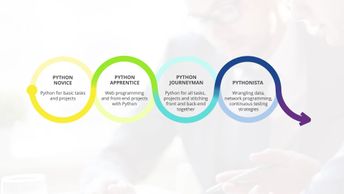Final Exam: Python Apprentice - assign attributes to objects of classes
- code a function to implement the Insertion Sort algorithm
- code a function to perform a breadth-first traversal of a graph
- control how you handle exceptions that your code may raise
- create a classes using Python
- create functions to perform common BST operations such as lookup and finding the minimum and maximum values
- define a class to represent a graph in the form of an adjacency matrix
- define a Linked List class and implement functions to insert a node at the head or the tail of the linked list
- define classes as abstract
- define multiple base classes for a single subclass
- define multiple inheritance levels in classes
- define the classes and functions required to implement a binary search tree
- describe a linked list, and its contents and structure
- describe how a sorted list of elements can be searched efficiently using a binary search
- describe how classes can be used as blueprints to create objects
- describe how the performance of operations and algorithms is expressed in terms of the size of the input
- describe the differences between the read(), readline(), and readlines() functions when working with files in Python
- describe the operations involved when sorting a list of values using the Selection Sort algorithm
- describe the steps involved in performing an Insertion Sort and compare it to the Bubble Sort
- distinguish between the r+ and a+ modes to read from and write to a file
- identify operations that run in constant time regardless of input
- identify the various properties of sorting algorithms that must be considered when selecting the right one for your data
- identify what makes a data structure and some of the purposes they serve
- implement a custom Stack class that includes functions for the common stack operations
- implement an adjacency set representation for a graph
- implement the Bubble Sort algorithm in Python
- implement the native Queue class of Python and perform the standard queue operations on it
- initialize class variables using the init special method
- invoke base class methods from subclasses
- outline the workings of the Shell Sort and recall the performance metrics of this divide and conquer algorithm
- pass arguments to initialize the state of a class object
- perform addition operations on custom objects
- perform floor division, modulo, and power-of operations
- perform subtraction operations on custom objects
- recall how class variables are different from instance variables
- recall how state and behavior can be encapsulated in a single unit
- recall the default base class for all Python classes
- recall the different ways in which to traverse a BST and describe the method to perform a breadth-first traversal
- recall the metrics on which algorithms and operations on data are evaluated
- recognize how exceptions are defined in a hierarchy and how related exceptions can be caught and handled
- recognize how the performance of operations and algorithms is expressed in terms of the size of the input
- recognize the differences between the read(), readline(), and readlines() functions when working with files in Python
- recognize the features available in popular Python libraries such as NumPy, random, and datetime
- recognize what trees and binary trees are and recall the properties of a binary search tree
- represent objects using customized strings
- run your code from the Python shell and recognize how to execute single-line and multi-line commands
- set up the Jupyter Notebook IDE to run and develop Python 2 code by installing a kernel for it
- summarize how insert and lookup operations occur in a BST
- summarize the pre-order and in-order depth-first traversal techniques for a BST
- use a try and except block to handle a Python exception
- use class hierarchies
- use pip to install a module in your environment and import it into your Python applications
- use pre-built Python modules to perform common operations by importing them into your source code
- use the 2to3 conversion tool to identify the lines in your Python 2 scripts that need to be altered for Python 3 compatibility
- use the native Queue class of Python and perform the standard queue operations on it
- use the open function in Python to open a file for reading
- work with class hierarchies
- work with utility methods on classes
- write the code to implement a Selection Sort
- write the partition and Quicksort functions to implement a Quicksort
|


